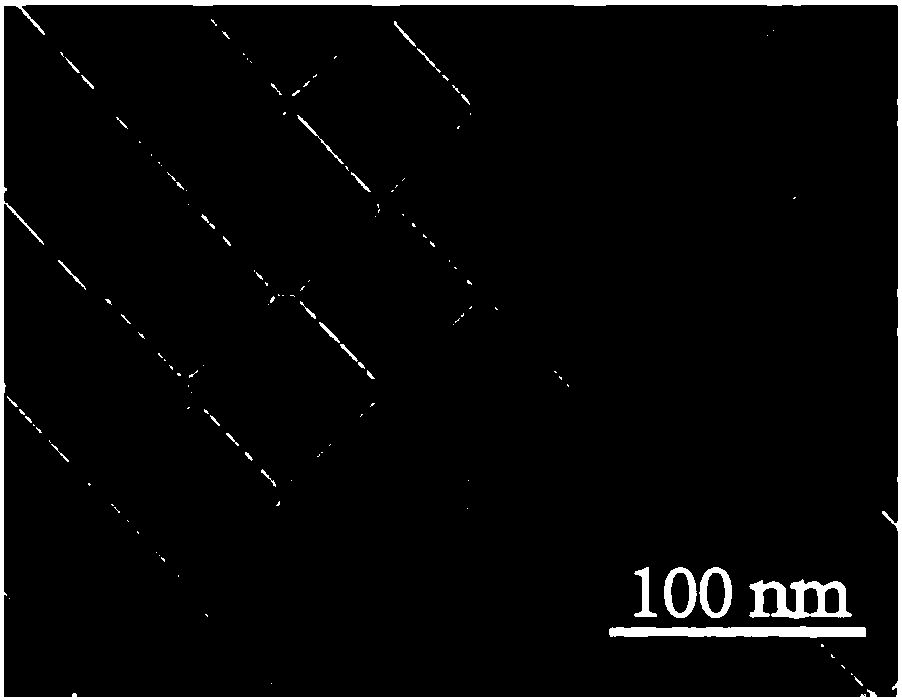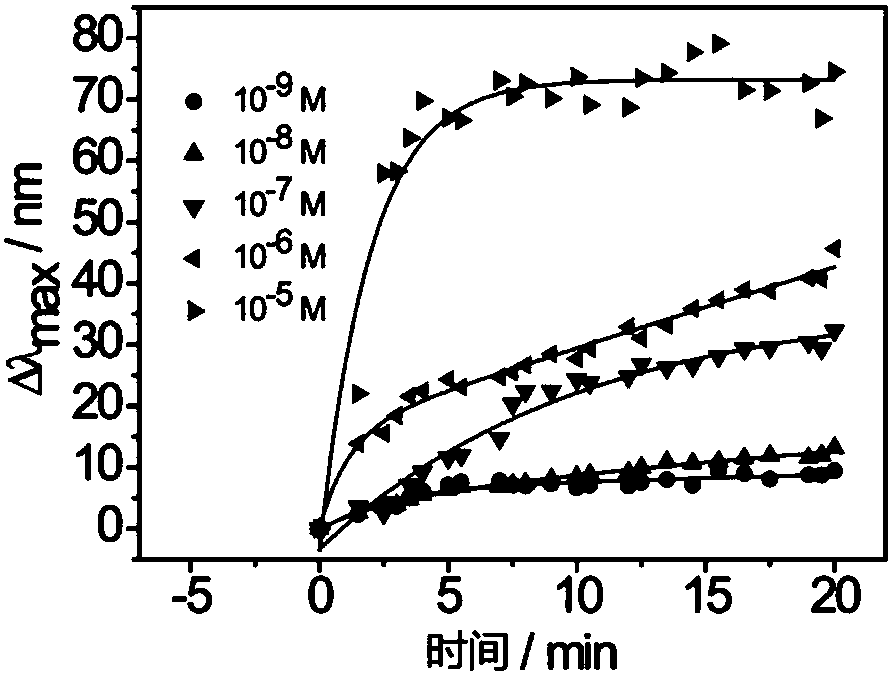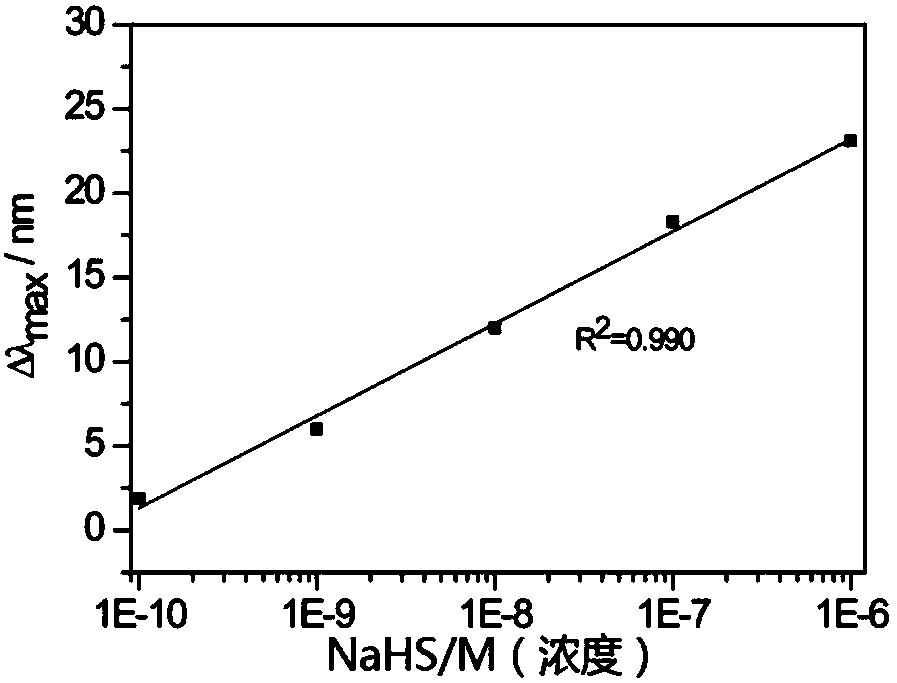Au@AgNCs-based sulfur ion detection method
A sulfur ion and sulfur measurement technology, which is applied in Raman scattering, material excitation analysis, etc., can solve the problem that the detection method is difficult to meet the needs of research, and achieve the effect of high sensitivity
- Summary
- Abstract
- Description
- Claims
- Application Information
AI Technical Summary
Problems solved by technology
Method used
Image
Examples
Embodiment 1
[0029] Step 1. Preparation of gold nanosphere solution:
[0030] a. 0.01mol / L NaBH in an ice-water bath 4 The solution was added to 0.01mol / L CTAC solution and 0.01mol / L HAuCl 4 In the mixed solution of the solution, the solution changed from yellow to brown in an instant. After stirring for 3 minutes, the solution was placed in a 28°C water bath for 2 hours;
[0031] b. Add 0.2mol / L CTAC solution, 0.0005mol / L HAuCl to the reaction flask 4 Solution, 0.1mol / L AA solution, after mixing evenly, add the seed solution of step a diluted 5 times. After stirring for 5 minutes, put it in a water bath at 36°C for 1 hour;
[0032] c. Add 0.2mol / L CTAC solution, 0.0005mol / L HAuCl to the reaction flask 4 Solution, 0.1mol / L AA solution, mix well and add the seed solution of step b. Put it in a water bath at 36° C. for 1 hour to obtain a gold nanosphere solution (spherical gold nanoparticle solution).
[0033] Step 2. Preparation of Au@AgNCs particles:
[0034] Add 0.2 mol / L CTAC solu...
Embodiment 2
[0036] Step 1. The gold-core-silver-shell nanocubes (Au@AgNCs) with a size of 40-100 nm prepared in Example 1 were prepared into a solution for later use, and the solution also contained 1 μmol-10 mmol of CTAB or CTAC as a stabilizer.
[0037] Step 2. Preparation of the plasma scattering test chip: add ultrapure water to a clean centrifuge tube, and then add an appropriate amount of the Au@AgNCs solution obtained in step 1 to dilute 5-50 times. The glass (thickness: 0.1-2mm) cleaned with ether, ethanol, and water in turn is immersed in the above diluted solution, and the AgNCs are fixed on the surface of the glass sheet by electrostatic adsorption. After soaking for 5-60s, take it out, rinse with ultrapure water to remove unadsorbed particles, and finally blow dry the glass sheet with nitrogen. The prepared glass sheet immobilized with Au@AgNCs is the plasma scattering test chip, and the nanoparticles attached to the glass sheet are the nanoprobes.
[0038] Step 3. Place the ...
Embodiment 3
[0042] Place the test chip prepared in Example 2 on the stage of a dark-field microscope, add 180 μL of ultrapure water to the center of the surface of the glass slide to form a circular water droplet, and move the operating platform so that the water droplet is located in the light path the very center of . Color images of the particles were collected under a dark-field microscope, followed by scattering spectra of individual nanoparticles under a microscattering spectrometer. Then add 20 μL of 10 -4 M sulfide ion solution, timing and real-time monitoring of the spectral changes of the scattering peaks of the particles caused by the reaction between the probe and sulfide ions. By repeating the above experimental operation, a single probe can detect 10 -5 ~10 -9 M Sulfide, such as figure 2 shown. It can be found that the probe can quickly detect sulfur ions within 2 minutes, and basically detect the concentration level of sulfur ions within 10 minutes.
PUM
| Property | Measurement | Unit |
|---|---|---|
| thickness | aaaaa | aaaaa |
| size | aaaaa | aaaaa |
Abstract
Description
Claims
Application Information
 Login to View More
Login to View More - R&D
- Intellectual Property
- Life Sciences
- Materials
- Tech Scout
- Unparalleled Data Quality
- Higher Quality Content
- 60% Fewer Hallucinations
Browse by: Latest US Patents, China's latest patents, Technical Efficacy Thesaurus, Application Domain, Technology Topic, Popular Technical Reports.
© 2025 PatSnap. All rights reserved.Legal|Privacy policy|Modern Slavery Act Transparency Statement|Sitemap|About US| Contact US: help@patsnap.com



